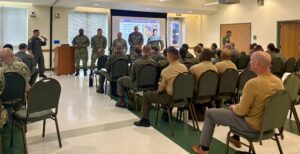
Lt. Chris Mecham, Naval Naval Aircrew Systems (PMA-202) Fleet Air Introduction/Liaison of Survival Aircrew Flight Equipment (FAILSAFE) lead, introduces the core FAILSAFE team at the program’s annual symposium May 5 near Naval Air Station Patuxent River, Md. The event welcomed more than 100 attendees, including parachute riggers, fleet aeromedical safety officers, and Naval Survival Training Institute instructors, who received fleet training on critical aircrew support systems, ensuring the safety of both aircrew and maintainers during flight missions. (U.S. Navy photo)
Military personnel from across the country gathered near NAS Patuxent River May 5-8 for an annual workshop aimed at strengthening fleet training on critical aircrew support systems, ensuring the safety of both aircrew and maintainers during flight missions.
Hosted by the Naval Aircrew Systems (PMA-202) Fleet Air Introduction/Liaison of Survival Aircrew Flight Equipment (FAILSAFE) team, the event welcomed more than 100 attendees, including parachute riggers, fleet aeromedical safety officers, and Naval Survival Training Institute instructors.
“Our job at PMA-202 is to equip and sustain aircrew with cutting-edge mission ready systems, ensuring their dominance in any operational environment,” said Capt. Joseph Kamara, who recently took lead of PMA-202. “What you all do is critical for the safety of our thousands of aircrew and maintainers around the world.”
The three-day training focused on the introduction, support, and assessment of new or modified Aviation Life Support Systems (ALSS), including ejection seats, oxygen systems, and survival vests. Attendees received essential instruction on system updates, emerging technologies, and direct engagement with PMA-202’s product and fleet support teams.
“This workshop equips warfighters with the expertise needed to navigate system transitions smoothly, ensuring fleet readiness and awareness of advancements in critical technologies,” said Lt. Chris Mecham, FAILSAFE team lead.
Staying informed on these advancements is crucial for aircrew and maintainer safety in life-or-death situations, reinforcing operational effectiveness and survivability, Mecham said.
“My first FAILSAFE workshop was in 2019, it was an eye-opening event that motivated me even more to complete the PR [parachute rigger] mission,” said Aircrew Survival Equipmentman Master Chief Rob Johnson. “This year’s event is no different, being able to see what happens in the background to support ALSS and hearing about updates on new equipment is really cool. It’s important for more maintainers to attend these, not only for knowledge, but for networking. Meeting the faces behind the emails and the voices behind the phone make it easier when reaching out for help.”
PMA-202 oversees the development, procurement, and sustainment of aircrew and maintainer-support systems, including ALSS, protective gear, vision systems, and survival equipment.

Attendees at Naval Aircrew Systems (PMA-202) Fleet Air Introduction/Liaison of Survival Aircrew Flight Equipment (FAILSAFE) annual symposium May 5 near Naval Air Station Pax River view displays of aviation support equipment used across the fleet. (U.S. Navy photo)

Lt. Chris Mecham, Naval Naval Aircrew Systems (PMA-202) Fleet Air Introduction/Liaison of Survival Aircrew Flight Equipment (FAILSAFE) lead, introduces the core FAILSAFE team at the program’s annual symposium May 5 near Naval Air Station Patuxent River, Md. The event welcomed more than 100 attendees, including parachute riggers, fleet aeromedical safety officers, and Naval Survival Training Institute instructors, who received fleet training on critical aircrew support systems, ensuring the safety of both aircrew and maintainers during flight missions. (U.S. Navy photo)


